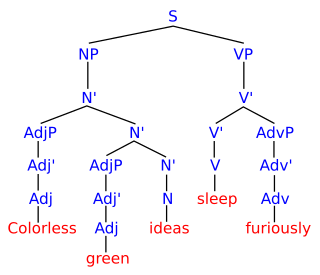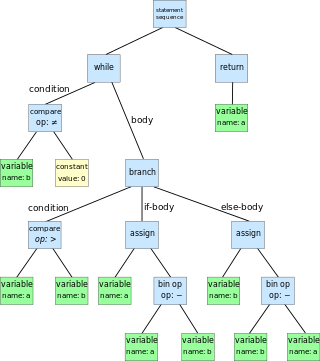
In logic, mathematics, computer science, and linguistics, a formal language consists of words whose letters are taken from an alphabet and are well-formed according to a specific set of rules called a formal grammar.
Prolog is a logic programming language that has its origins in artificial intelligence and computational linguistics.
In logic and computer science, unification is an algorithmic process of solving equations between symbolic expressions. For example, using x,y,z as variables, the singleton equation set { cons(x,cons(x,nil)) = cons(2,y) } is a syntactic first-order unification problem that has the substitution { x ↦ 2, y ↦ cons(2,nil) } as its only solution.

An abstract syntax tree (AST) is a data structure used in computer science to represent the structure of a program or code snippet. It is a tree representation of the abstract syntactic structure of text written in a formal language. Each node of the tree denotes a construct occurring in the text. It is sometimes called just a syntax tree.

A parse tree or parsing tree or derivation tree or concrete syntax tree is an ordered, rooted tree that represents the syntactic structure of a string according to some context-free grammar. The term parse tree itself is used primarily in computational linguistics; in theoretical syntax, the term syntax tree is more common.
In computer science, pattern matching is the act of checking a given sequence of tokens for the presence of the constituents of some pattern. In contrast to pattern recognition, the match usually has to be exact: "either it will or will not be a match." The patterns generally have the form of either sequences or tree structures. Uses of pattern matching include outputting the locations of a pattern within a token sequence, to output some component of the matched pattern, and to substitute the matching pattern with some other token sequence.
Parsing, syntax analysis, or syntactic analysis is the process of analyzing a string of symbols, either in natural language, computer languages or data structures, conforming to the rules of a formal grammar. The term parsing comes from Latin pars (orationis), meaning part.
A formal system is an abstract structure or formalization of an axiomatic system used for inferring theorems from axioms by a set of inference rules.
In programming language theory, semantics is the rigorous mathematical study of the meaning of programming languages. Semantics assigns computational meaning to valid strings in a programming language syntax. It is closely related to, and often crosses over with, the semantics of mathematical proofs.
In mathematics, computer science, and logic, rewriting covers a wide range of methods of replacing subterms of a formula with other terms. Such methods may be achieved by rewriting systems. In their most basic form, they consist of a set of objects, plus relations on how to transform those objects.
Montague grammar is an approach to natural language semantics, named after American logician Richard Montague. The Montague grammar is based on mathematical logic, especially higher-order predicate logic and lambda calculus, and makes use of the notions of intensional logic, via Kripke models. Montague pioneered this approach in the 1960s and early 1970s.
In computer science, an abstract semantic graph (ASG) or term graph is a form of abstract syntax in which an expression of a formal or programming language is represented by a graph whose vertices are the expression's subterms. An ASG is at a higher level of abstraction than an abstract syntax tree, which is used to express the syntactic structure of an expression or program.
In computer science, graph transformation, or graph rewriting, concerns the technique of creating a new graph out of an original graph algorithmically. It has numerous applications, ranging from software engineering to layout algorithms and picture generation.
Constraint Handling Rules (CHR) is a declarative, rule-based programming language, introduced in 1991 by Thom Frühwirth at the time with European Computer-Industry Research Centre (ECRC) in Munich, Germany. Originally intended for constraint programming, CHR finds applications in grammar induction, type systems, abductive reasoning, multi-agent systems, natural language processing, compilation, scheduling, spatial-temporal reasoning, testing, and verification.
In computer science, higher-order abstract syntax is a technique for the representation of abstract syntax trees for languages with variable binders.

Diagrammatic reasoning is reasoning by means of visual representations. The study of diagrammatic reasoning is about the understanding of concepts and ideas, visualized with the use of diagrams and imagery instead of by linguistic or algebraic means.
The categorical abstract machine (CAM) is a model of computation for programs that preserves the abilities of applicative, functional, or compositional style. It is based on the techniques of applicative computing.
In mathematical logic, an uninterpreted function or function symbol is one that has no other property than its name and n-ary form. Function symbols are used, together with constants and variables, to form terms.
Nominal terms are a metalanguage for embedding object languages with binding constructs into. Intuitively, they may be seen as an extension of first-order terms with support for name binding. Consequently, the native notion of equality between two nominal terms is alpha-equivalence. Nominal terms came out of a programme of research into nominal sets, and have a concrete semantics in those sets.
In computational learning theory, induction of regular languages refers to the task of learning a formal description of a regular language from a given set of example strings. Although E. Mark Gold has shown that not every regular language can be learned this way, approaches have been investigated for a variety of subclasses. They are sketched in this article. For learning of more general grammars, see Grammar induction.



